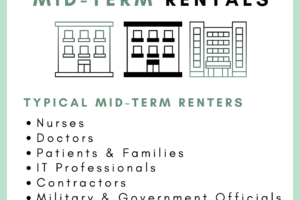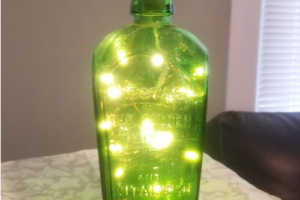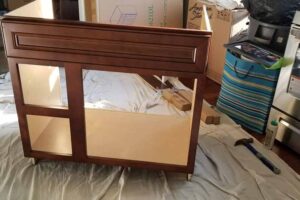I thought sanding the larger areas of each room was challenging – with the uneven, beveled, cupped and bowed wood – but the edging proved to be even more difficult… not just in one or two rooms, but every single room AND closet came with it’s own set of challenges.
Sanding Hardwoods in The Living Room, Dining Room & Hallway
Sanding the hardwoods in the living room, dining room and hallway was the absolute worst!
Here’s the reason only the edging was gumming up our sanding discs – check out the picture below. Basically everywhere there is lighter wood (essentially a foot and half wide around the entire living room, dining room and hallway) there were all kinds of finishes that had been poorly (and probably carelessly) applied to the floor over the years.
 From a combination of what we’ve been told, previous hardwood floor experience, what I’ve researched and just from working on sanding the hardwoods for days on end, we think the hardwoods had some type of wax, a stain, a polyurethane and some other type of stain and maybe another type of poly – the result is that it literally MELTS when you sand it.
From a combination of what we’ve been told, previous hardwood floor experience, what I’ve researched and just from working on sanding the hardwoods for days on end, we think the hardwoods had some type of wax, a stain, a polyurethane and some other type of stain and maybe another type of poly – the result is that it literally MELTS when you sand it.
Sanding Hardwoods in The Office
In what will be the future office, there was obviously some type of flooring on top of the hardwood floors that a previous owner must have taken up. Unfortunately, that old flooring left behind black foamy backing. I scraped all the foam as best I could with my 5-in-1 tool but even the small residue left behind gummed up the edging sandpaper pads within a few feet! It was crazy!
The closet in the office had a different type of stain all together! To make things worse, with the heat radiating off the sander the stain sort of melted and, on par with the rest of the room (and house for that matter) it also gummed up our sandpaper pads quickly.
After the hardwood floors in the office I thought maybe, just maybe the two bedrooms wouldn’t be so bad since they were covered in carpet.
Sanding Hardwoods in the Bedrooms
I was expecting the end bedroom’s edging to come up the easiest in the house because they were the best looking floors to begin with. However, the house had other plans for us. Even though the floor didn’t look like it had the same type of waxy coating, it did! So yet again, we were gumming up pads left and right in that room.
The middle bedroom became a huge problem because there was leftover padding that was so old and matted down it became almost like a glue! So YET AGAIN, we were gumming up sand paper pads left and right.
By now you’re probably wishing I’d get to the point… what I learned from sanding my hardwood floors! Okay, okay… So, our current fixer upper’s floors were in a lot worse shape than our first flip’s floors (try saying that ten times fast) and required A LOT of elbow grease (and sweat, blood and tears – and no joke I have a scar from this fiasco. Warning! The machine gets hot and can melt your skin!)
I also wound up sanding down our front porch since we had extra time with our sander rental. And let me tell you, if there was a project I ever regretted starting, it was that one. I had a terrible time getting the 30 layers of paint off and it was actually quite painful when the little chips went flying into my legs. The porch luckily enough didn’t have any wax or stain, so I was really just battling with the paint layers.
 Here’s what I learned from the sanding hardwood floor fiasco
Here’s what I learned from the sanding hardwood floor fiasco
1. The sanders get hot!
I burned myself pretty good when changing out the sandpaper on the drum sander – I literally singed my arm skin off. I’m sure any piece of equipment you use for hours on end is going to get hot so I should have been more careful. Even the edger got so hot that it melted the paint on the porch after just one pass of the sander!
2. Any kind of bow, unevenness or cupping in the hardwood floors is huge problem
I actually realized this on the hardwood floors we refinished in our first flip. Those hardwoods were in almost perfect condition except for a few boards that were slightly uneven creating the TINIEST little lip. But that tiny lip can cause problems! I noticed that the lower board didn’t get sanded as good or even at all because the higher board determined where the sandpaper could reach. Does that make sense? So I was left with multiple boards where the corners were completely untouched and in desperate need of a palm sander. (Check out my tutorial for sanding hardwoods that aren’t in bad shape here.)
3. Buy wayyyyyy more sandpaper than you think you need

74 Pieces of sandpaper later…
We wound up running out of sandpaper because we tried to guess how many of each grit we’d need and guessed totally wrong! Unfortunately, the people at the both places we rented from didn’t have much advice on what and how many of each grit to buy so it was a learning experience. We personally wound up using a ton of low grits and barely any higher grit – the best part was we guessed that the opposite was going to be true so we purchased more higher grit sandpaper than lower grit. Needless to say we ran out of paper. And the picture above shows how many we wound up using – 74 to be exact.
4. Don’t skip sandpaper grits
I learned that you should never skip grits when sanding a hardwood floor. Scratches from 24 grit sandpaper will not sand out with 60 grit. So you must use all grits finer than 24 in order to get the scratches out (in this case it would 24, 36, 60, and then 80.)
5. Crosscutting can be magical
We all know we should always sand with the grain of the wood, right? Well there is actually one exception to that. When the floors are water damaged, or severely cupped or bowed, crosscutting can help. This is where you sand on an angle to the wood (only about 10-15 degrees), however, you must go back over the area with the same grit parallel to the wood in order to get these scratches out.
Truthfully, I messed up on this and crosscut 90 degrees to the wood and in some areas we were never able to get the scratches out. But instead of doing my own research on that (like I’ve done now) I listened to the guy at the rental place thinking he had more experience than me so he would probably know better. But you learn from your mistakes right?
6. Wood putty is not a miracle worker
When we refinished our hardwood floors in our first flip, we went around and filled all the nail holes, dents and large gaps between the boards with stainable wood putty. After we let it dry we sanded the floors as you normally would. However, even the the floors in our current fixer upper are way worse than those at our flip house, we decided not to fill every single gap and gouge. And that’s because we found out that the wood putty “fix” is only temporary! Especially if you live in an area with drastic temperature differences, where the wood expands and contracts. The wood putty doesn’t expand and contract like the wood so it just eventually falls out.
And if you have any more questions or want to read more in-depth about hardwood floors, I came across this awesome site [HERE] that I wish I had found before I did both of my hardwood floors. They offer a blog, resources, rentals and products.
And as always I think it’d be really awesome to connect with you on Instagram or Facebook! And if you like what you’re reading, subscribe to my blog. (I ONLY send emails when a new blog post is out. No spam. I promise.)





